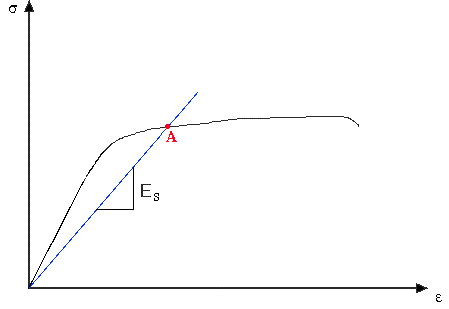Secant modulus is defined as the slope of a line connecting the origin and a specified point (like yield point) in stress-strain diagrams. Instead of elastic modulus, which is the slope of the tangent line at origin, the secant line connects the origin and yield point. But what is the purpose of this method? I know this is used to approximate the behaviour of materials at the nonlinear region, but why do we use secant modulus instead of tangent modulus near the yield point? Tangent near the yield point would probably approximate much better. The secant modulus method seems hugely inaccurate to me.
-
1$\begingroup$ How do you plan on defining yield point in order to decide what the tangent modulus at it is? (Especially with materials with a gradual roll-off and no pronnounced knee.) Secant modulus provides you with an 'average' behaviour across a region of interest (provided you define your point appropriately). On your diagram, assuming your structure is working in the zero to A region, doing linear elastic calcs using Es will in most cases get you a closer-to-true deflection than using tangent E at A, or tangent E at zero, or tangent E at elastic limit. It's just a convenient pragmatic approximation. $\endgroup$– achrnCommented Oct 13, 2020 at 15:18
2 Answers
In the linear region of the stress strain curve the tangent modulus is equal to the secant modulus. Stress= Etangent x strain = Esecant x strain.
However at point A you can see from the curve that stress = Esecant x strain, not E tangent x strain.
The modules of elasticity at yield point (or below) is called Young Modulus, while the material still behave in elastic region. In this case the Secant Modulus and Young Modulus is equivalent.
However while entering the elastic-plastic region and plastic region. As the material become incompressible, the study of the material properties requires more complex consideration such as the poison ratio changes in the region.
Methamatically, Secant Modulus is included in the theory during simplification of the stress-strain relationship of material in those regions.
